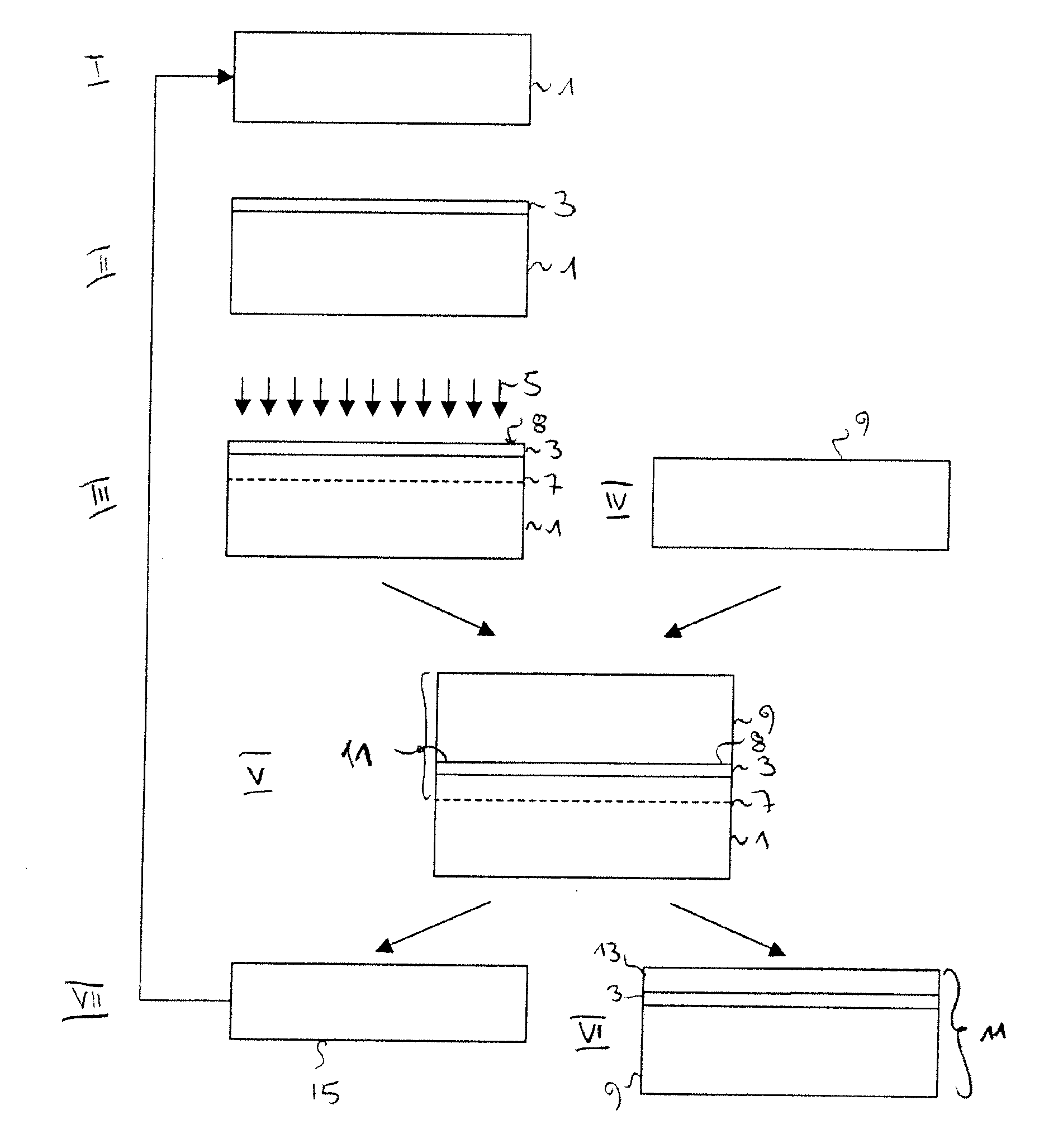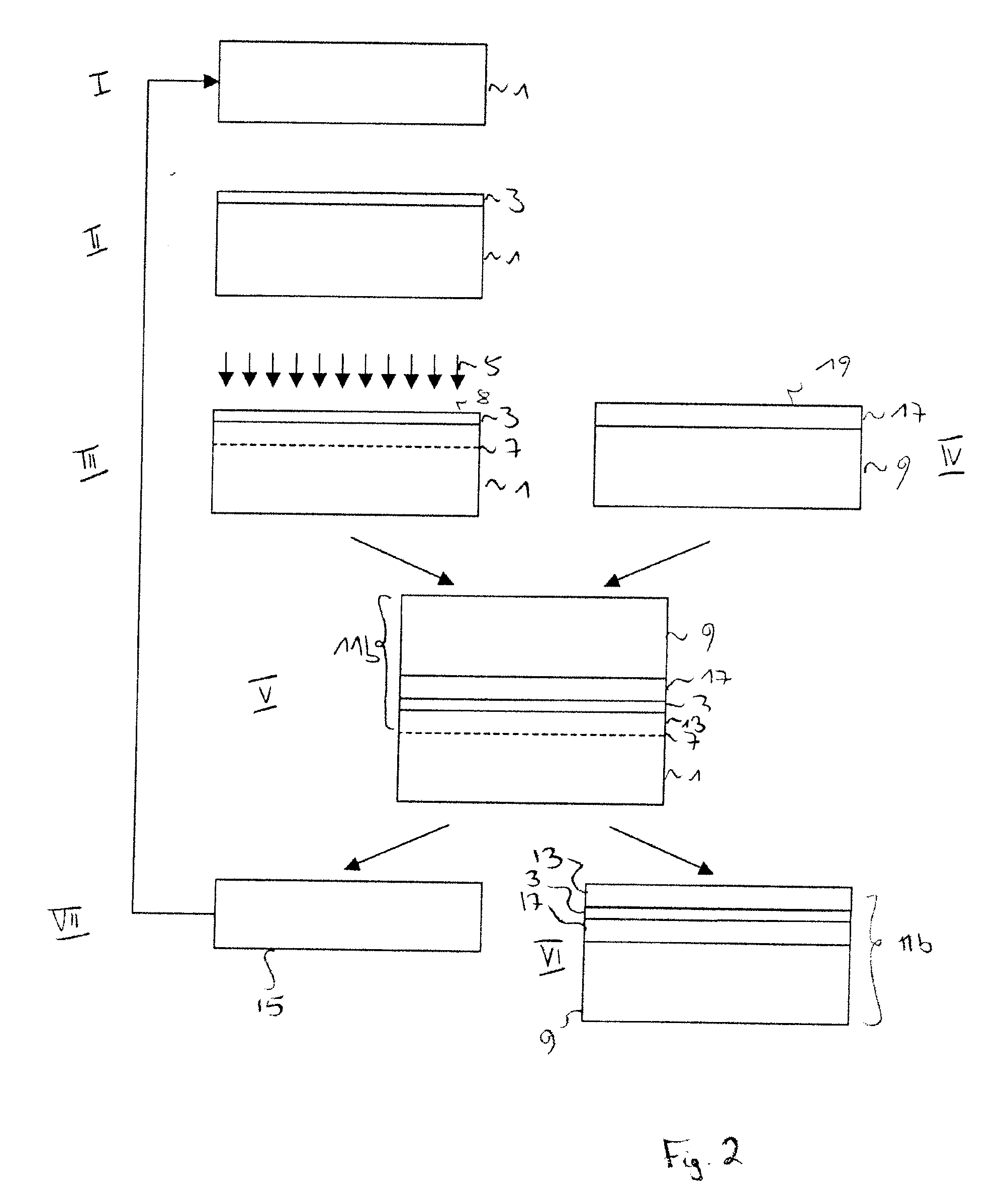Method for manufacturing compound material wafer and corresponding compound material wafer
a technology of compound material and manufacturing method, which is applied in the direction of basic electric elements, electrical apparatus, semiconductor devices, etc., can solve the problems of reducing the need for extensive additional steps, and the state of the art, so as to speed up the process, improve the crystalline quality of the donor substrate, and increase the number of reuses of the donor substrate.
- Summary
- Abstract
- Description
- Claims
- Application Information
AI Technical Summary
Benefits of technology
Problems solved by technology
Method used
Image
Examples
first embodiment
[0031]FIG. 1 illustrates the inventive method for manufacturing compound material wafers. The method will be described for a silicon on insulator (SOI) type compound material wafer. This, nevertheless, only serves as an example and the inventive method is also applicable to other types of material compound wafers.
[0032]Step I of the inventive method consists in providing an initial donor substrate 1 which, in the preferred embodiment, is a silicon wafer. Step II illustrates a step of forming an insulating layer 3 on the silicon wafer 1. Here the insulating layer 3 is a silicon dioxide layer (SiO2), which is formed by a thermal treatment under oxidizing conditions. According to this first embodiment of the invention the insulating layer 3 is thermally grown to a thickness of at most 500 Å.
[0033]In Step III, atomic species 5, in particular, hydrogen or rare gas ions such as helium, are implanted under predetermined dose and energy conditions through the insulating layer 3 to create a ...
second embodiment
[0056]The third insulating layer 21 is a deposited layer, wherein deposition is preferably carried out at relatively low temperatures, in particular, at less than 750° C., more in particular, in a range of 400° C. to 600° C. By doing so the thermal budget seen by the donor substrate 1 is kept low, so that the donor substrate can still be reused more than 3 times, in particular five to ten times. Like in the second embodiment, it again becomes possible to obtain an insulating layer with a thickness, which can be freely chosen as a function of the applications for which the compound material wafer is intended for, as the insulating layer thickness corresponds to the sum of the thickness of the first insulating layer 3 and the thickness of the third insulating layer 17, the later having a thickness that can be chosen freely.
[0057]Apart from that, all the other advantages and variants as disclosed with respect to the first and second embodiments are also achieved in this embodiment.
[005...
sixth embodiment
[0071]FIG. 6 illustrates the inventive method for fabricating a hybrid orientation wafer. In contrast to the previous embodiments, this embodiment does not use any insulating layers. As a consequence, the donor substrate is not subject to a thermal layer forming treatment, which could negatively influence the crystalline quality of the donor substrate. Therefore also in this embodiment it is possible to reuse the donor substrate more than three times.
[0072]Step I of the method according to this embodiment relates to providing an initial donor substrate 51 which has a first crystal orientation. This can for example be a silicon wafer of (1,0,0) or (1,1,0) crystalline orientation.
[0073]Step II then illustrates the implantation of atomic species 5 into the donor substrate 51 to create a predetermined splitting area 7 in this substrate 51. The conditions under which implantation occurs are comparable to the ones of the previously described embodiments and are not repeated here as they a...
PUM
| Property | Measurement | Unit |
|---|---|---|
| temperature | aaaaa | aaaaa |
| temperature | aaaaa | aaaaa |
| temperatures | aaaaa | aaaaa |
Abstract
Description
Claims
Application Information
 Login to View More
Login to View More - R&D
- Intellectual Property
- Life Sciences
- Materials
- Tech Scout
- Unparalleled Data Quality
- Higher Quality Content
- 60% Fewer Hallucinations
Browse by: Latest US Patents, China's latest patents, Technical Efficacy Thesaurus, Application Domain, Technology Topic, Popular Technical Reports.
© 2025 PatSnap. All rights reserved.Legal|Privacy policy|Modern Slavery Act Transparency Statement|Sitemap|About US| Contact US: help@patsnap.com



